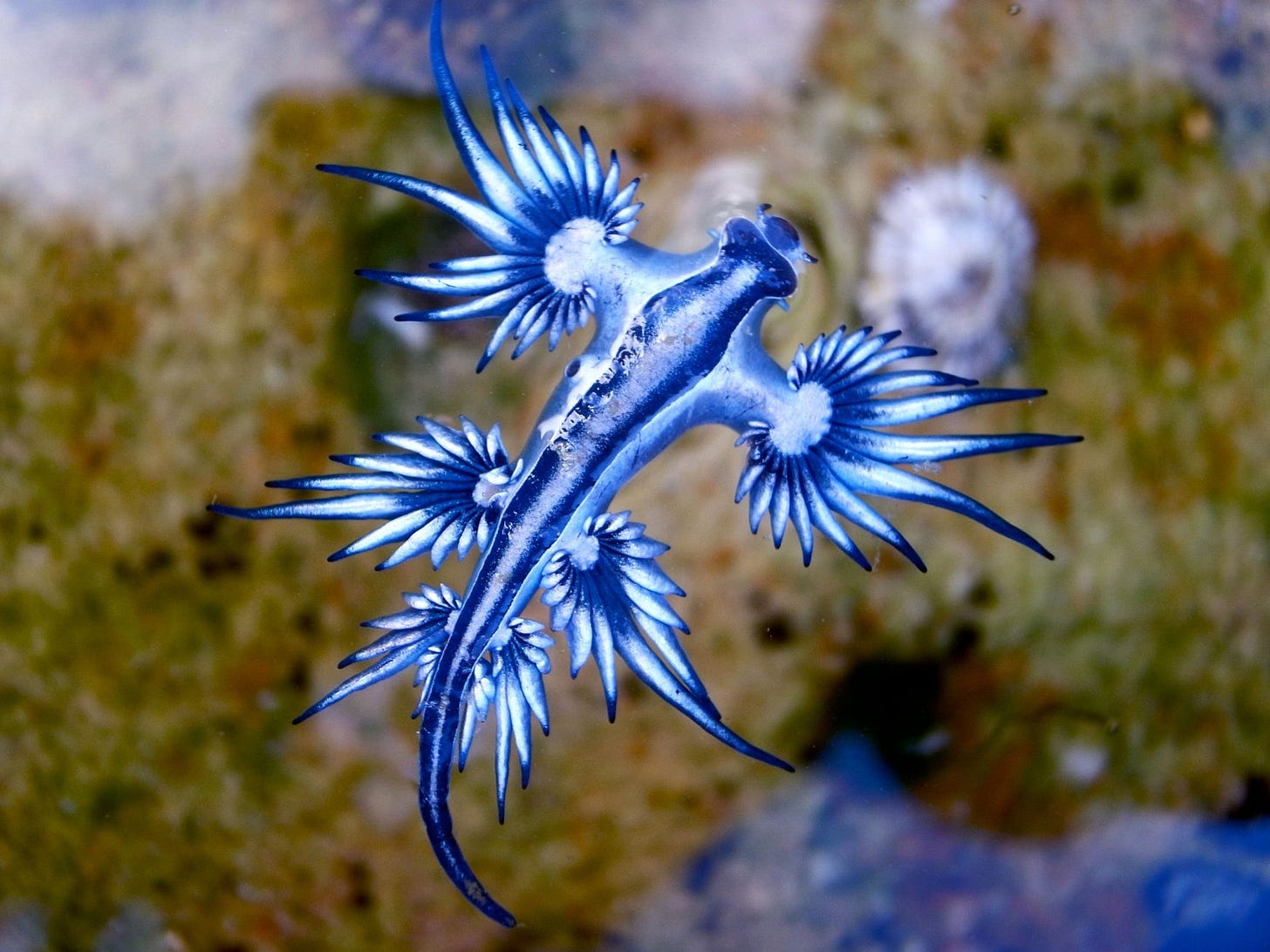Flash Fiction as Its Own Unique Form
Glaucus Atlanticus (blue sea dragon)
Hi friends,
I’m often asked to define flash fiction in interviews and almost out of a sense of duty, I provide the standard answer (flash fiction is a story of 1,000 words or fewer), but it feels so dissatisfying to say this. Yes, that’s flash at its most basic but to those of us who read, write, and teach it, it’s so much more than that! To say flash is a short story, only smaller, feels much too, well, reductive.
Flash fiction, I believe, is its own unique literary form, not merely a short story in miniature, and we should teach it as such.
I love what W. Todd Kaneko says in his essay, “Planets in Miniature: On Kandor and Compression in Flash Fiction,” from the wonderful flash anthology edited by Megan Giddings, Forward: 21st Century Flash Fiction (Aforementioned Productions, 2019):
“A flash fiction could be called a little story, but not in the way that a dollhouse is a miniature of those mansions on the affluent side of town. While a flash fiction takes up less real estate on the page than a longer work, it can deliver an equal amount of story, just compressed. In great part, compression in flash fiction is not about shrinking, but about hyper-efficient narrative.”
How then to teach / demonstrate “hyper-efficient narrative”?
We can of course have students write a longer, traditional short story, then instruct how to cut it down to size:
Trim the fat by eliminating redundancies, asides, excess description, needless backstory and exposition.
Sharpen dialogue by distilling it to its essence, to only what serves characterization and plot.
Edits like the above, as well as “arriving late and leaving early” are just fundamental ways to make any writing stronger. And we’re still teaching and defining flash as a shorter, short story.
But flash writers can and should aspire to concision/compression/distillation up front. And we as teachers of the form, should encourage an openness to all the many ways to achieve it. We can, for example, avail ourselves of the tools of poets to create emotional power via language and imagery, rhythm and sound. Flash fiction is a form uniquely suited to experimentation and innovation and hybridity and there are numerous published examples we can use in the classroom or workshop. Hermit crab flash, where borrowed forms are used to tell a story, is also becoming very popular.
This is the approach I take in my own workshops and I think this is how, going forward, flash fiction will truly come into its own. In my view, flash can employ, but isn’t beholden to, the same rules as the short story. Given far less space, flash writers must make more use of white space, nuance, and subtext. A sense of story and movement and resonance may be achieved any number of exciting ways. And I say we try them all!
In an interview in the 2017 edition of Best Small Fictions (Braddock Avenue Books), Joy Williams was asked what advice she’d give to new writers who sought to “write small.”
“Everybody writes too long and too much anyway, sacrificing significance for story. Truth be told, we all want to be poets.”
Your Prompt
Let’s practice concision up front by pouring narrative into a tiny container. Read Laura Gilpin’s poem, below. See how compressed and potent the imagery is and how the “tomorrow” and “but tonight” lends a sense of movement in time. Write a microfiction, emulating this structure (or reversing it to “Tonight…” then “But tomorrow…”). Use image, sensory detail, and specificity as Gilpin does here to create emotional resonance without relying on abstraction. Convey a strong sense of place and include an animal if you can!
The Two-Headed Calf
Tomorrow, when the farm boys find this
freak of nature, they will wrap his body
in newspaper and carry him to the museum.
But tonight he is alive and in the north
field with his mother. It is a perfect
summer evening: the moon rising over
the orchard, the wind in the grass.
And as he stares into the sky, there
are twice as many stars as usual.
Have fun with this! If you enjoyed this newsletter, I’d love for you to share it. Thanks so much! See you next month.
Kathy




your lessons are always so good, robust, succinct. I look forward to buying your flash craft book!
This post I feels like a GIFT right now. I’m teaching intro to fiction to high schoolers this semester and next week I’m starting a unit on different forms of short fiction and I’ve been wrecking my brain trying to articulate what flash fiction IS. Furthermore, it’s hard to breakdown why/how a piece is successful. (It just IS!) great post. :)